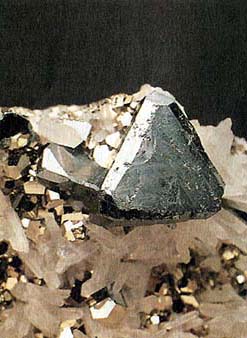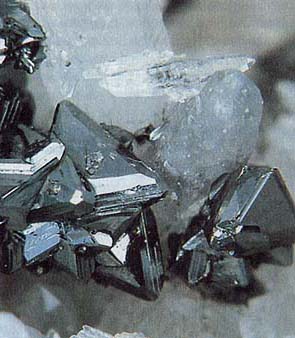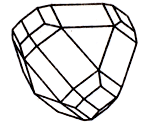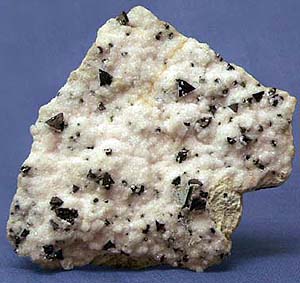Stone, minerals and semiprecious of the world stone
Sulphide: Tetrahedrite -->rus

 Diagnostic cart.
Diagnostic cart.
Excellent copies of Tetrahedrite of perfect octahedral habitus with characteristic metallic brilliance
Cu12 Sb4 S13
Crystal structure cube
Hardness on the Mohs scale 3-4
Specific unit weight mass 4,6-5,2
Cleavage non-existent
Fracture, break wrong
Colors from grey to black
Colors in powder triturate from black to russet
Glance (glitter, glare) metallic

Tetrahedrite (stibium antimonial faded ore), is a sulfide of copper and antimony. Glance (glitter, glare) metallic, opaque. Colors: from grey-steel to iron-black, powders and raids of chalcopyrite sometimes give him yellow, gold color. A line is darkly-grey, brown. Fracture, break padman, uneven. Fragile. Cleavage non-existent. Appears in hydrothermal deposits. Crystals (cube Crystal structure) grow on the walls of cracks, there is spersion. Aggregates are dense - downlow or grainy. Has an important industrial value as copper ore. Jointly with freibergite (silver faded ore) and shvatcite (mercury-silver faded ore) belongs to the group of the faded ores. Places of distribution: Garc, Ore mountains (Germany), Peru, Bolivia, USA, CIS.
The crystals of Tetrahedrite are enough ordinary, quite often with well well-educated forms. The size of crystals arrives at 15 sm sometimes Habitus more frequent than all tetrahedron; sometimes tops are cut away the verges of the second tetrahedron, and ribs - by the verges of cube. A mineral can be presented also dense and grainy the masses. Colors of Tetrahedrite - steel-grey to ferrous-black. It is mainly opaque. There are very rare varieties, poorly allowing rose light. Glance (glitter, glare) typically metallic, sometimes enough intensive. A mineral is enough hard and heavy; Cleavage not especially shows up. Fragile, fracture undistinctly semipadman. Is a grey metallic mineral consisting of a sulphide of copper, iron, and antimony, often in the form of tetrahedral crystals: it is a source of copper. Formula: (Cu,Fe)12Sb4S13.
 Steel-grey, black-black (darker, than tennantite), with pied oxide tint; crystals, covered thin tape of chalcopyrite, brass-yellow have sometimes, gold color. Form of crystals. Tetrahedrons, dodecahedrons, rhombic-dodecahedron shape (diamond forms). Crystalline structure. Difficult. Class of symmetry. Geksatetraedricheskiy - 43m. Cleavage. Almost non-existent. Aggregates. Dense, grainy, downlow, often find out the three-cornered shading.
Steel-grey, black-black (darker, than tennantite), with pied oxide tint; crystals, covered thin tape of chalcopyrite, brass-yellow have sometimes, gold color. Form of crystals. Tetrahedrons, dodecahedrons, rhombic-dodecahedron shape (diamond forms). Crystalline structure. Difficult. Class of symmetry. Geksatetraedricheskiy - 43m. Cleavage. Almost non-existent. Aggregates. Dense, grainy, downlow, often find out the three-cornered shading.
Diagnostic indication.
Fuse melt easily; we will dissolve in an aquafortis. On coal the faded ores easily give grey kinglet; arsenic (As2O3) and stibium antimonial (Sb2O3) sublimate is thus selected. A behavior is in acids. Dissolves in HNO3 with a selection the oxides of antimony (Sb2O3) are grey, depending on oscillation of chemical composition attitude changes toward reagents.
Origin provenance genesis.
Usually be found in hydrothermal vein, lode, mines, more frequent than all in the deposits of contact-metamorphic origin, low- and medium-temperature. Be found there foremost in an association with the various minerals of copper, lead, zinc and silver.
Deposit minefield mine and use.
Numerous large deposits are dissipated all over the world. Exceptionally beautiful crystals are known in Sakatekas (Mexico), Cumeb (Namibia), in the states Nativeia, North Carolina, Colorado, Montana, Utah and Idaho in the USA, in different places in Peru, Bolivia, England, Norway, Sweden, Switzerland, Germany, Czech Republic, Hungary. One of main base minerals of copper and silver (if contains the last element).
